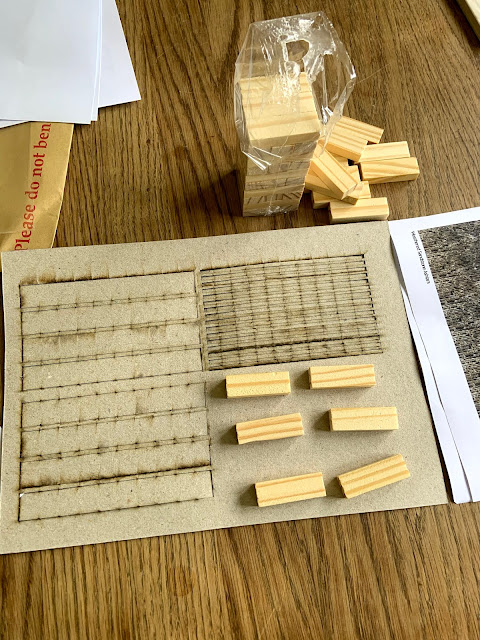One thing that’s been holding me back from starting the Civil War siege campaign is the lack of a walled place to besiege. Whilst the campaign game won't always feature the Place* on the table, it would be pretty embarrassing if the Parliamentarians were to turn up with pick and shovel to dig their lines if there is nothing to beleaguer.
* I'll probably use this word for now as I'm not sure yet whether it will be a large castle or a small town
Within my existing resources I had a couple of wall sections, two towers and a gateway piece bought from Leven Miniatures way back in the early days of the Plague. Originally I wan't convinced that they would look right, so I started casting about for other ideas.
Then I hit upon the idea of Jenga blocks so I ordered a pack of cheap imitations. The pack came with 48 blocks. The individual blocks are only 4.5 cm long. Just a wee bit longer than the width of my Foot bases. Quite handy. Only problem is the other dimensions are only 1.5 and 1 cm. To create a decent height wall I would need to stack them 2 high. I would then need to use other blocks as platforms for the models to stand on to reach the battlements.
Then came the question of how to make wooden blocks look like castle/city walls. The easiest was to buy some printed sheets with stone or brickwork printed on. The sort that railway modellers use. I found a supplier of N-gauge accessories and ordered a couple of different types. N-gauge is sometimes described as 2mm to the foot, so a bit bigger than 10mm figures, but not much assuming 17th century men were not much above 5 feet tall**, not that it matters much as I'm taking a mix and match approach to scales when it comes to terrain and buildings.
So here are a few pics of the bits and pieces ready for experimentation.
 |
| Sandstone ashlars. 5 A4 sheets to a pack, so plenty of material. |
 |
| This set of stone and brick wall comes with capping stones, and pre-cut card to stick the paper to. |
 |
| Comparison of the size of wooden blocks and printed wall sections. There's enough to cover 20 blocks on one side only, which is OK if I make the rear face "earth backed". |
Using the wooden blocks I'd probably need to stack them 2 high, to get a decent height. I'd need to use about 32 blocks to create a decent length of curtain wall*** which means I'd require another sheet of the brick and stone pattern. Or I could mix and match styles of stone. Castles and town walls weren't always built at the same time. To create crenallations, I could cut short sections out of the paper (backed with card).
** It is a big assumption on my part admittedly. For all I know they could have built them bigger in those days than men of the 18th or early 19th century.
*** at a rough estimate, there perimeter of Pontefract castle was c 800 yards, thought there were additional walls between the wards.
All potentially good.
But then I decided to dig out the Leven walls again, which are higher than I remembered. Below is a shot of them with some Foot for size. The musketeers are on the Jenga blocks - two high in each case stacked on the 1.5cm side and 1cm side respectively. Not sure which looks better.
The beauty of the Leven-based solution is that it will be less fiddly. I would still make use of the blocks and I could possibly dress them with the 'stone paper' or paint them earth colours. They will be more durable too than the paper/block solution. The downsides are that I need another £20 worth of wall and towers and still need to paint them. Incidentally, I put some of the beading 'earthworks' I prepared a few years ago in front of the Leven walls and it looks pretty good as an earth retainer or as an earthwork covered way. If I did this, it would leave me short of siege works, but I can always buy some more beading.
I also have half an idea for using the stone paper to make some permanent, polygonal, black-powder era, artillery fortification. A "Vauban fort" in other words.
Hmmm!
































